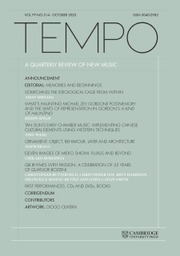No CrossRef data available.
Article contents
Schoenberg's ‘Atonal’ Music
Published online by Cambridge University Press: 04 February 2010
Extract
Schoenberg's ‘atonal’ (i.e. nontonal, pre-serial) music continues to offer stubborn resistance to analysis. The co-existence within the oeuvre of widely diverging, even conflicting, ‘linguistic’ directions has resulted in a theoretical literature inclined to illuminate the individual work or specific technical feature rather than to lay the foundations for useful analytical generalizations.
- Type
- Research Article
- Information
- Copyright
- Copyright © Cambridge University Press 1974
References
1Forte, Allen: ‘Context and Continuity in an Atonal Work: A Set-theoretic Approach’. Perspectives of New Music, Spring 1963CrossRefGoogle Scholar
2Forte, Allen: ‘A Theory of Set Complexes’. Journal of Music Theory, Winter 1964CrossRefGoogle Scholar
3Forte, Allen: ‘Sets and Nonsets in Schoenberg's Atonal Music’. Perspectives of New Music, Fall-Winter 1972CrossRefGoogle Scholar
6Travis, Roy: ‘Directed Motion in Schoenberg and Webern’. Perspectives of New Music, Spring-Summer 1966CrossRefGoogle Scholar
6Brinkmann, Reinhold: Arnold Schoenberg: Drei Klavierstücke Op. 11. Franz Steiner Verlag, Wiesbaden, 1969Google Scholar
7Lewin, David: ‘Inversional Balance as an Organizing Force in Schoenberg's Music and Thought’. Perspectires of New Music, Spring-Summer 1968CrossRefGoogle Scholar
8Perle, George: Serial Composition and Atonality. University of California Press, Berkeley, 1968Google Scholar
10Friedheim, Philip: ‘Rhythmic Structure in Schoenberg's Atonal Compositions’. Journal of the American Musicological Society, Spring 1966CrossRefGoogle Scholar


